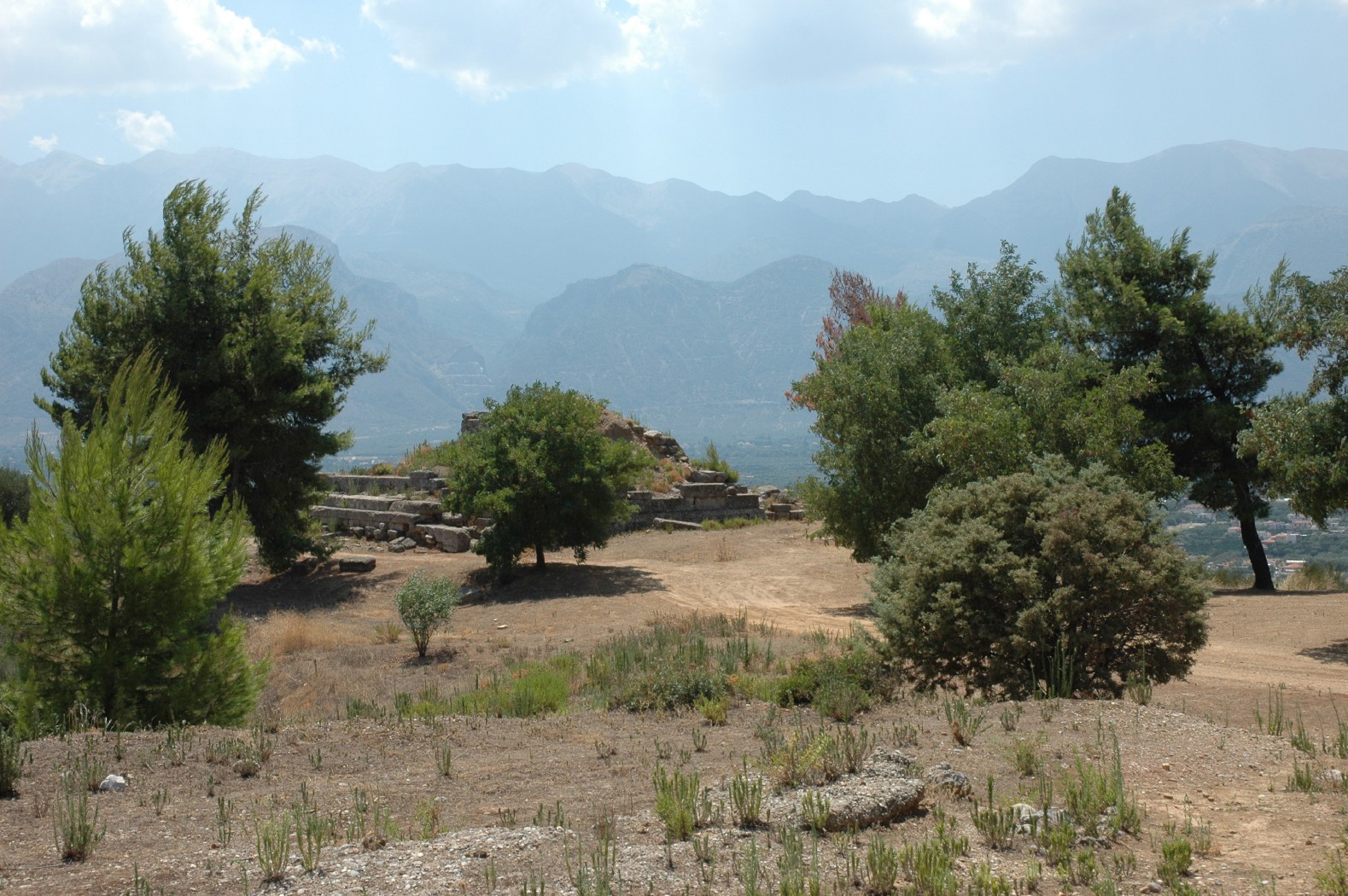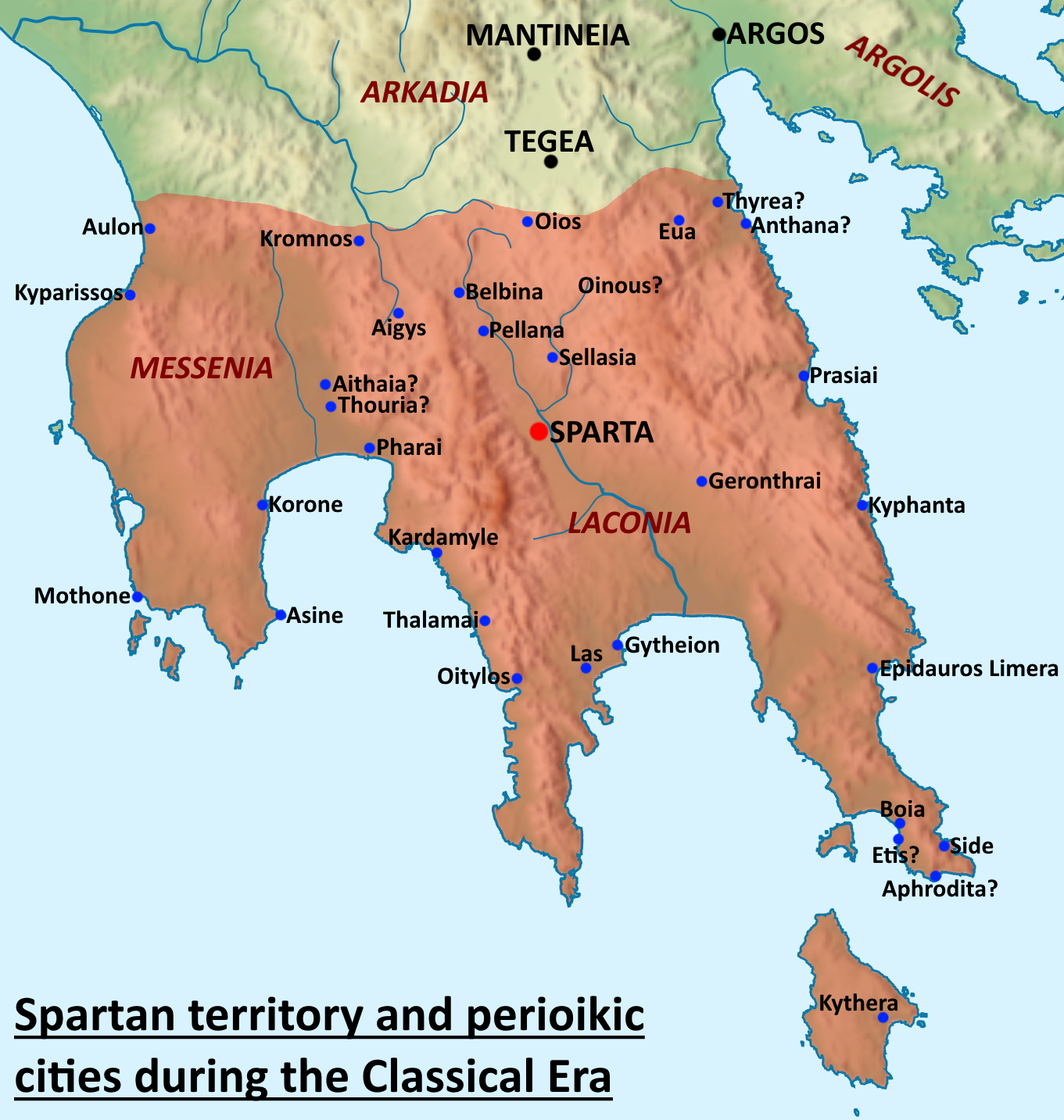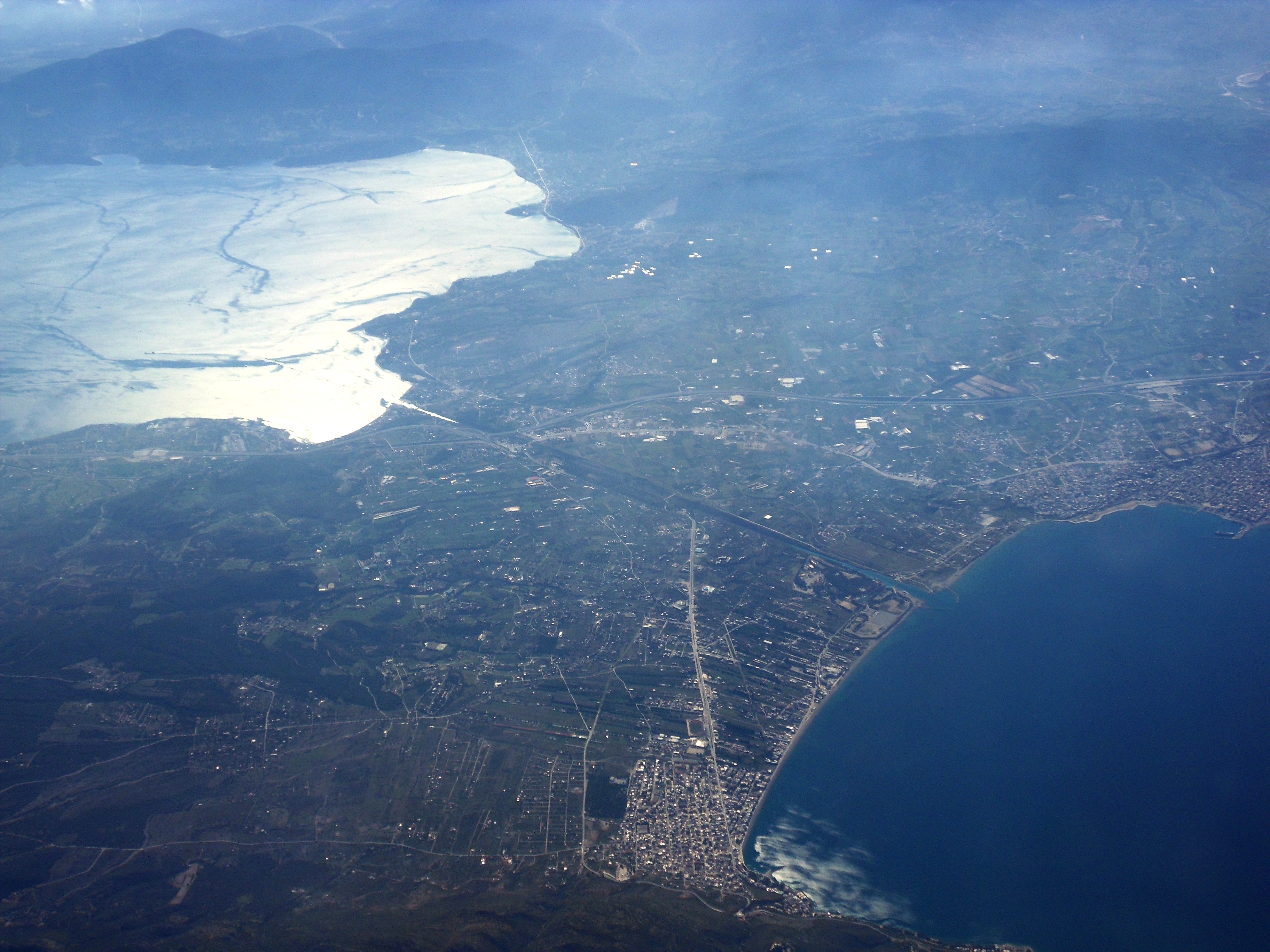|
Ancient Sparta
Sparta was a prominent city-state in Laconia in ancient Greece. In antiquity, the city-state was known as Lacedaemon (), while the name Sparta referred to its main settlement in the valley of Evrotas river in Laconia, in southeastern Peloponnese. Around 650 BC, it rose to become the dominant military land-power in ancient Greece. Sparta was recognized as the leading force of the unified Greek military during the Greco-Persian Wars, in rivalry with the rising naval power of Athens. Sparta was the principal enemy of Athens during the Peloponnesian War (431–404 BC), from which it emerged victorious after the Battle of Aegospotami. The decisive Battle of Leuctra against Thebes in 371 BC ended the Spartan hegemony, although the city-state maintained its political independence until its forced integration into the Achaean League in 192 BC. The city nevertheless recovered much autonomy after the Roman conquest of Greece in 146 BC and prospered during the Roman Empi ... [...More Info...] [...Related Items...] OR: [Wikipedia] [Google] [Baidu] |
Perioeci
The Perioeci or Perioikoi (, ) were the second-tier citizens of the ''polis'' of Sparta until 200 BC. They lived in several dozen cities within Spartan territories (mostly Laconia and Messenia), which were dependent on Sparta. The ''perioeci'' only had political rights in their own city, while the course of the Spartan state exclusively belonged to Spartan citizens, or Spartiates. The name ''perioeci'' roughly means "those dwelling around/nearby", deriving from , ''peri'', "around", and , ''oîkos'', "dwelling, house". ''Perioeci'' and Spartans were collectively called the ''Lakedaimonians''. They had a central role in the Spartan economy, controlling commerce and business, as well as being responsible for crafts and manufacturing, including producing the weapons and armour of the Spartan army, as the higher-ranking Spartan citizens considered all commercial and money-making activities to be unworthy of them. The ''perioeci'' were also the only people allowed to freely travel o ... [...More Info...] [...Related Items...] OR: [Wikipedia] [Google] [Baidu] |
Menelaion
The archaeological site of Menelaion (translit. Menelaeion) () is located approximately 5 km from the modern city of Sparta. The geographical structure of this site includes a hill complex (Northern hill, Menelaion, Profitis Ilias and Aetos). The archaic name of the place is mentioned as Therapne (). General context Fluvial deposits of the valley of Eurotas, mild climate and low hills which protect the area, are forming the general geographical and geological context of the archaeological site which revealed few Middle Helladic findings on the Northern hill and major settlement of the Mycenaean period in the Menelaion. Ideology It is considered that Helen of Troy appeared initially in Homeric epic poetry, circa 8th century BC. Besides epos, she appears in lyric poetry, in history, in theatrical plays, even in rhetorical exercises. Helen, and her husband Menelaus, belong to a large group of heroes and heroines worshiped throughout Greece. These heroes, heroines ... [...More Info...] [...Related Items...] OR: [Wikipedia] [Google] [Baidu] |
Spartan Hegemony
Spartan hegemony refers to the period of dominance by Sparta in Greek affairs from 404 to 371 BC. Even before this period the polis of Sparta was the greatest Spartan army, military land power of classical Ancient Greece, Greek antiquity and governed, dominated or influenced the entire Peloponnese. The defeat of the Athenians and the Delian League in the Peloponnesian War in 431–404 BC resulted in a short-lived Spartan dominance of the southern Greek world from 404 to 371 BC.Jones, Nicholas F. ''Politics and Society in Ancient Greece.'' Westport, CT: Prager, 2008 Due to their mistrust of others, Spartans discouraged the creation of records about their internal affairs. The only histories of Sparta are from the writings of Xenophon, Thucydides, Herodotus and Plutarch, none of whom were Spartans. Plutarch was writing several centuries after the period of Spartan hegemony had ceased. This creates difficulties in understanding the Spartan political system, which was distinctly differen ... [...More Info...] [...Related Items...] OR: [Wikipedia] [Google] [Baidu] |
Thebes, Greece
Thebes ( ; , ''Thíva'' ; , ''Thêbai'' .) is a city in Boeotia, Central Greece (administrative region), Central Greece, and is one of the oldest continuously inhabited cities in the world. It is the largest city in Boeotia and a major center for the area along with Livadeia and Tanagra. It played an important role in Greek myths, as the site of the stories of Cadmus, Oedipus, Dionysus, Heracles and others. One myth had the city founded by Agenor, which gave rise to the (now somewhat obscure) name "Agenorids" to denote Thebans. Archaeological excavations in and around Thebes have revealed a Mycenaean Greece, Mycenaean settlement and clay tablets written in the Linear B script, indicating the importance of the site in the Bronze Age. Thebes was the largest city of the ancient region of Boeotia and was the leader of the Boeotian confederacy. It was a major rival of Classical Athens, ancient Athens, and sided with the Achaemenid Empire, Persians during the Second Persian invasi ... [...More Info...] [...Related Items...] OR: [Wikipedia] [Google] [Baidu] |
Battle Of Leuctra
The Battle of Leuctra (, ) was fought on 6 July 371 BC between the Boeotians led by the Thebes (Greece), Thebans, and the History of Sparta, Spartans along with their allies amidst the post–Corinthian War conflict. The battle took place in the vicinity of Leuctra, a village in Boeotia in the territory of Thespiae. The Theban victory shattered Sparta's immense influence over the Greek peninsula, which Sparta had gained with its victory in the Peloponnesian War a generation earlier. Prelude In 371 BC, the newly established democracy of Thebes had elected four Boeotarchs, the traditional title of the generals of the Boeotia, Boeotian League, and so proclaimed their intention of reconstituting the aforementioned league that Sparta had disbanded.Tritle 1987, p. 80 During this period, Thebes had an ally in Athens, but Athens was far from happy with the treatment Plataea had received. When it came to swearing an oath to respect the treaty, Sparta swore on behalf of itself and its al ... [...More Info...] [...Related Items...] OR: [Wikipedia] [Google] [Baidu] |
Battle Of Aegospotami
The Battle of Aegospotami () was a naval confrontation that took place in 405 BC and was the last major battle of the Peloponnesian War. In the battle, a Spartan fleet under Lysander destroyed the Athenian navy. This effectively ended the war, since Athens could not import grain or communicate with its empire without control of the sea. Prelude Lysander's campaigns In 405 BC, following the severe Spartan defeat at the Battle of Arginusae, Lysander, the commander who had been responsible for the first Spartan naval successes, was reinstated in command. Since the Spartan constitution prohibited any commander from holding the office of navarch more than once, he was appointed as a vice-admiral instead, with the clear understanding that this was a mere legal fiction. One of Lysander's advantages as a commander was his close relationship with the Achaemenid Dynasty, Persian prince Cyrus the Younger, Cyrus. Using this connection, he quickly raised the money to begin rebuilding the Spa ... [...More Info...] [...Related Items...] OR: [Wikipedia] [Google] [Baidu] |
History Of Athens
Athens is one of the List of oldest continuously inhabited cities, oldest named cities in the world, having been continuously inhabited for perhaps 5,000 years. Situated in southern Europe, Athens became the leading city of ancient Greece in the first millennium BC, and its cultural achievements during the 5th century BC laid the foundations of Western world, Western civilization. The earliest evidence for human habitation in Athens dates back to the Neolithic period. The Acropolis of Athens, Acropolis served as a fortified center during the Mycenaean Greece, Mycenaean era. By the 8th century BC, Athens had evolved into a prominent city-state, or Polis, ''polis'', within the region of Attica. The 7th and 6th centuries BC saw the establishment of legal codes, such as those by Draco (legislator), Draco, Solon and Cleisthenes, which aimed to address social inequalities and set the stage for the development of democracy. In the early 5th century BC, Athens played a central role in ... [...More Info...] [...Related Items...] OR: [Wikipedia] [Google] [Baidu] |
Classical Athens
The city of Athens (, ''Athênai'' ; Modern Greek: Αθήναι, ''Athine'' ) during the classical period of ancient Greece (480–323 BC) was the major urban centre of the notable '' polis'' ( city-state) of the same name, located in Attica, Greece, leading the Delian League in the Peloponnesian War against Sparta and the Peloponnesian League. Athenian democracy was established in 508 BC under Cleisthenes following the tyranny of Isagoras. This system remained remarkably stable, and with a few brief interruptions, it remained in place for 180 years, until 322 BC (aftermath of Lamian War). The peak of Athenian hegemony was achieved in the 440s to 430s BC, known as the Age of Pericles. In the classical period, Athens was a centre for the arts, learning, and philosophy, the home of Plato's Academy and Aristotle's Lyceum, Athens was also the birthplace of Socrates, Plato, Pericles, Aristophanes, Sophocles, and many other prominent philosophers, writers, and politici ... [...More Info...] [...Related Items...] OR: [Wikipedia] [Google] [Baidu] |
Greco-Persian Wars
The Greco-Persian Wars (also often called the Persian Wars) were a series of conflicts between the Achaemenid Empire and Polis, Greek city-states that started in 499 BC and lasted until 449 BC. The collision between the fractious political world of the Greeks and the enormous empire of the Persians began when Cyrus the Great conquered the Greek-inhabited region of Ionia in 547 BC. Struggling to control the independent-minded cities of Ionia, the Persians appointed Tyrant#Historical forms, tyrants to rule each of them. This would prove to be the source of much trouble for the Greeks and Persians alike. In 499 BC, the tyrant of Miletus, Aristagoras, embarked on an Siege of Naxos (499 BC), expedition to conquer the island of Naxos Island, Naxos, with Persian support; however, the expedition was a debacle and, preempting his dismissal, Aristagoras incited all of Hellenic Asia Minor into rebellion against the Persians. This was the beginning of the Ionian Revolt, which would last unti ... [...More Info...] [...Related Items...] OR: [Wikipedia] [Google] [Baidu] |
Peloponnese
The Peloponnese ( ), Peloponnesus ( ; , ) or Morea (; ) is a peninsula and geographic region in Southern Greece, and the southernmost region of the Balkans. It is connected to the central part of the country by the Isthmus of Corinth land bridge which separates the Gulf of Corinth from the Saronic Gulf. From the late Middle Ages until the 19th century, the peninsula was known as the Morea, a name still in colloquial use in its demotic form. The peninsula is divided among three administrative regions: most belongs to the Peloponnese region, with smaller parts belonging to the West Greece and Attica regions. Geography The Peloponnese is a peninsula located at the southern tip of the mainland, in area, and constitutes the southernmost part of mainland Greece. It is connected to the mainland by the Isthmus of Corinth, where the Corinth Canal was constructed in 1893. However, it is also connected to the mainland by several bridges across the canal, including two submers ... [...More Info...] [...Related Items...] OR: [Wikipedia] [Google] [Baidu] |
Evrotas (river)
The Evrotas (Modern Greek: ) or Eurotas () is the main river of Laconia and one of the major rivers of the Peloponnese, in Greece. The river's springs are located just northwest of the border between Laconia and Arcadia, at Skortsinos. The river is also fed by underwater springs at Pellana and by tributaries coursing down from Mt. Taygetos and Mt. Parnon, which flank the Evrotas Valley to the west and east, respectively. The river is long, flowing in a north-south direction and emptying into the Laconian Gulf. Its drainage basin is . Etymology The classical Evrotas was changed to Iri in the Middle Ages and only changed back to Evrotas in recent times. Evrotas, however, is not the most ancient name of the river. It does not appear in the works of Homer, which purport to recount the stories and geography of Mycenaean Greece. In that legendary time, the Dorians are not known to have been present in the Evrotas Valley. At some time prior to being called Evrotas, the river was t ... [...More Info...] [...Related Items...] OR: [Wikipedia] [Google] [Baidu] |
Evrotas Valley
The Evrotas Valley is an 82 km elongated valley between Taygetus and Parnon which traverses Laconia, Greece. Homer called the valley Kili Lakedemon, while Sparta, Mystras and Gytheio are the main cities within the valley. It is one of the largest valleys in Greece. The valley is predominantly an agricultural region that contains many citrus groves, olive groves, and pasture lands. It is the location of the largest orange production in the Peloponnese and probably in all of Greece. ''Lakonia'', a brand of orange juice, is based in Amykles. The Evrotas Valley records the highest summer mean maximum temperatures in Greece. Geography The Evrotas River is the main river traversing the valley. The valley runs until the delta of the river in the Laconian Gulf. Modern day Sparta, the capital of the prefecture of Laconia, lies on the eastern foothills of Taygetus, Mount Taygetos. The city has been built upon the site of ancient Sparta, whose Acropolis lies north of the modern city. ... [...More Info...] [...Related Items...] OR: [Wikipedia] [Google] [Baidu] |










